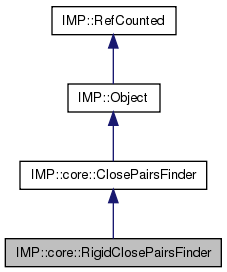The class finds all close pairs consisting of particles taken from the passed list(s) (if they are not rigid bodies) or members of rigid bodies passed as input. That is, given an input list l, for each pair of particles p, q taken from the list, that are closer than the distance threshold, it returns
p or q are RigidBody particles it returns (p,q)p and q are RigidBody particles, it returns all r,s) where r is a member of p and s is member of q and r and s are closer than the distance thresholdp,s) or r,q) as appropriate if only one of p or q is a rigid body.Consequently, the user must ensure that the RigidBody are assigned a radius that encloses all of their RigidMember particles.
It uses another ClosePairsFinder to find which pairs of particles in the input list or lists are close. Your choice of this can be passed to the constructor.
The bounding spheres are kept in internal coordinates for the rigid body and transformed on the fly. It would probably be faster to cache the tranformed results.
The particles are divided up using a grid. The number of grid cells to use should be explored. In addition, with highly excentric sets of points, there will be too many cells.
import IMP
import IMP.core
import IMP.atom
import IMP.helper
import IMP.container
# This example addes a restraint on nonbonded interactions
# Since it is between two rigid bodies, internal interactions are ignored
m= IMP.Model()
# The particles in the rigid bodies
rbps0= IMP.core.create_xyzr_particles(m, 3, 1)
rbps1= IMP.core.create_xyzr_particles(m, 3, 1)
rbp0= IMP.Particle(m)
rbp1= IMP.Particle(m)
rbss0 = IMP.core.RigidBody.setup_particle(rbp0, IMP.core.XYZs(rbps0))
rbss1 = IMP.core.RigidBody.setup_particle(rbp1, IMP.core.XYZs(rbps1))
lsc= IMP.container.ListSingletonContainer()
lsc.add_particle(rbp0)
lsc.add_particle(rbp1)
tr= IMP.core.TableRefiner()
tr.add_particle(rbp0, rbps0)
tr.add_particle(rbp1, rbps1)
# Set up the nonbonded list
nbl= IMP.container.ClosePairContainer(lsc, 0, IMP.core.RigidClosePairsFinder(tr), 2.0)
# Set up excluded volume
ps= IMP.core.SphereDistancePairScore(IMP.core.HarmonicLowerBound(0,1))
evr= IMP.container.PairsRestraint(ps, nbl)
evri= m.add_restraint(evr)
# Set up optimizer
o= IMP.core.ConjugateGradients()
o.set_model(m)
done=False
while not done:
try:
o.optimize(1000)
except IMP.ModelException:
for d in [rbss0, rbss1]:
d.set_transformation(IMP.algebra.Transformation3D(IMP.algebra.get_random_rotation_3d(),
IMP.algebra.get_random_vector_in(IMP.algebra.BoundingBox3D(IMP.algebra.Vector3D(0,0,0),
IMP.algebra.Vector3D(10,10,10)))))
else:
done=True
cover_members()

Public Member Functions | |
| ParticlePairsTemp | get_close_pairs (Particle *a, Particle *b) const |
| ParticlePairsTemp | get_close_pairs (SingletonContainer *pca, SingletonContainer *pcb) const |
| ParticlePairsTemp | get_close_pairs (SingletonContainer *pc) const |
| ContainersTemp | get_input_containers (SingletonContainer *a, SingletonContainer *b) const |
| ContainersTemp | get_input_containers (SingletonContainer *pc) const |
| ParticlesTemp | get_input_particles (SingletonContainer *a, SingletonContainer *b) const |
| ParticlesTemp | get_input_particles (SingletonContainer *pc) const |
| internal::MovedSingletonContainer * | get_moved_singleton_container (SingletonContainer *c, Model *m, double thresold) const |
| virtual std::string | get_type_name () const |
| virtual ::IMP::VersionInfo | get_version_info () const |
| RigidClosePairsFinder (ClosePairsFinder *cpf, Refiner *r) | |
| RigidClosePairsFinder (Refiner *r) | |
| Use the default choice for the ClosePairsFinder. | |
| void | set_distance (double d) |
Friends | |
| template<class T > | |
| void | IMP::internal::unref (T *) |
| IMP::core::RigidClosePairsFinder::RigidClosePairsFinder | ( | Refiner * | r | ) |
Use the default choice for the ClosePairsFinder.
Use rep to generate the list of representation particles.